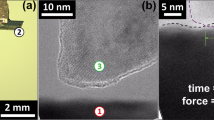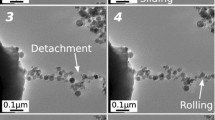Abstract
Molecular simulation is a powerful tool for studying the nanotribology of single-asperity contacts, but computational limits require that compromises be made when choosing tip sizes. To assess and correct for the finite size effects, complementary finite element (FE) and molecular statics (MS) simulations examining the effects of tip size (height and radius) on contact stiffness and stress were performed. MS simulations of contact between paraboloidal tips and a flat, rigid diamond substrate using the 2B-SiCH reactive empirical bond-order potential were used to generate force–displacement curves and stress maps. Tips of various radii and heights, truncated by a rigid boundary, were formed from carbon- and silicon-containing materials so that they possessed differing elastic properties. Results were compared to FE simulations with matching geometries and elastic properties. FE analysis showed that the rigid boundary at the back of the tip influences the contact stiffness strongly, deviating from the Hertz model for small tip heights and radii. By examining the relationships between force, tip height, tip radii, and elastic properties obtained with FE simulations, a map interpolation method is presented that accounts for the effect of tip size and enables the extraction of Young’s modulus from MS force–displacement data. Furthermore, the FE results show that the effect of the finite size of the tip on contact stress is less pronounced than its effect on stiffness. The MS simulations also demonstrate that stress propagation within the tip is significantly impacted by the structure of the tip.










Similar content being viewed by others
References
Szlufarska, I., Chandross, M., Carpick, R.W.: Recent advances in single-asperity nanotribology. J. Phys. D Appl. Phys. 41, 123001 (2008)
Carpick, R.W., Salmeron, M.: Scratching the surface: fundamental investigations of tribology with atomic force microscopy. Chem. Rev. 97, 1163–1194 (1997)
Persson, B.N.J.: Sliding Friction: Physical Principles and Applications. Springer, New York (2000)
Tangpatjaroen, C., Grierson, D.S., Shannon, S., Jakes, J.E., Szlufarska, I.: Size dependence of nanoscale wear of silicon carbide. ACS Appl. Mater. Interfaces 9, 1929–1940 (2017)
Greenwood, J.A., Williamson, J.B.P.: Contact of nominally flat surfaces. Proc. R. Soc. A Math. Phys. Eng. Sci. 295, 300–319 (1966)
Persson, B.N.J.: Contact mechanics for randomly rough surfaces. Surf. Sci. Rep. 61, 201–227 (2006)
Müser, M.H.: Rigorous field-theoretical approach to the contact mechanics of rough elastic solids. Phys. Rev. Lett. 100, 55504 (2008)
Giessibl, F.J.: Atomic resolution of the silicon (111)-(7x7) surface by atomic force microscopy. Science 267, 68–71 (1995)
Yacoot, A., Koenders, L.: Aspects of scanning force microscope probes and their effects on dimensional measurement. J. Phys. D Appl. Phys. 41, 103001 (2008)
Garcia, R., Knoll, A.W., Riedo, E.: Advanced scanning probe lithography. Nat. Nanotechnol. 9, 577–587 (2014)
Piner, R.D., Zhu, J., Xu, F., Hong, S., Mirkin, C.A.: Dip-pen nanolithography. Science 283, 661–663 (1999)
Xie, X.N., Chung, H.J., Sow, C.H., Wee, A.T.S.: Nanoscale materials patterning and engineering by atomic force microscopy nanolithography. Mater. Sci. Eng. R 54, 1–48 (2006)
Sha, Z., Sorkin, V., Branicio, P.S., Pei, Q., Zhang, Y., Srolovitz, D.J.: Large-scale molecular dynamics simulations of wear in diamond-like carbon at the nanoscale. Appl. Phys. Lett. 103, 73118 (2013)
Chandross, M., Lorenz, C.D., Stevens, M.J., Grest, G.S.: Simulations of nanotribology with realistic probe tip models. Langmuir 24, 1240–1246 (2008)
Vahdat, V., Ryan, K.E., Keating, P.L., Jiang, Y., Adiga, S.P., Schall, J.D., Turner, K.T., Harrison, J.A., Carpick, R.W.: Atomic-scale wear of amorphous hydrogenated carbon during intermittent contact: a combined study using experiment, simulation, and theory. ACS Nano 8, 7027–7040 (2014)
Si, L., Wang, X.: Nano-adhesion influenced by atomic-scale asperities: a molecular dynamics simulation study. Appl. Surf. Sci. 317, 710–717 (2014)
Ryan, K.E., Keating, P.L., Jacobs, T.D.B., Grierson, D.S., Turner, K.T., Carpick, R.W., Harrison, J.A.: Simulated adhesion between realistic hydrocarbon materials: effects of composition, roughness, and contact point. Langmuir 30, 2028–2037 (2014)
Hu, X., Tourek, C.J., Ye, Z., Sundararajan, S., Martini, A.: Structural and chemical evolution of the near-apex region of an atomic force microscope tip subject to sliding. Tribol. Lett. 53, 181–187 (2014)
Dong, Y., Li, Q., Martini, A.: Molecular dynamics simulation of atomic friction: a review and guide. J. Vac. Sci. Technol. A Vac. Surf. Film 31, 30801 (2013)
Sarobol, P., Chandross, M., Carroll, J.D., Mook, W.M., Bufford, D.C., Boyce, B.L., Hattar, K., Kotula, P.G., Hall, A.C.: Room temperature deformation mechanisms of alumina particles observed from in situ micro-compression and atomistic simulations. J. Therm. Spray Technol. 25, 82–93 (2016)
Pastewka, L., Robbins, M.O.: Contact area of rough spheres: large scale simulations and simple scaling laws. Appl. Phys. Lett. 108, 221601 (2016)
Luan, B., Robbins, M.O.: The breakdown of continuum models for mechanical contacts. Nature 435, 929–932 (2005)
Brukman, M.J., Gao, G., Nemanich, R.J., Harrison, J.A.: Temperature dependence of single-asperity diamond-diamond friction elucidated using AFM and MD simulations. J. Phys. Chem. C 112, 9358–9369 (2008)
Mo, Y., Szlufarska, I.: Nanoscale heat transfer: single hot contacts. Nat. Mater. 12, 9–11 (2013)
Mo, Y., Szlufarska, I.: Roughness picture of friction in dry nanoscale contacts. Phys. Rev. B Condens. Matter Mater. Phys. 81, 35405 (2010)
Jacobs, T.D.B., Ryan, K.E., Keating, P.L., Grierson, D.S., Lefever, J.A., Turner, K.T., Harrison, J.A., Carpick, R.W.: The effect of atomic-scale roughness on the adhesion of nanoscale asperities: a combined simulation and experimental investigation. Tribol. Lett. 50, 81–93 (2013)
Luan, B., Robbins, M.O.: Contact of single asperities with varying adhesion: comparing continuum mechanics to atomistic simulations. Phys. Rev. E Stat. Nonlinear Soft Matter Phys. 74, 26111 (2006)
Grierson, D.S., Liu, J., Carpick, R.W., Turner, K.T.: Adhesion of nanoscale asperities with power-law profiles. J. Mech. Phys. Solids 61, 597–610 (2013)
Chandross, M., Lorenz, C.D., Stevens, M.J., Grest, G.S.: Probe-tip induced damage in compliant substrates. J. Manuf. Sci. Eng. 132, 30916 (2010)
Hertz, H.: Über die berührung fester elastischer Körper (On the contact of rigid elastic solids). J. reine und Angew. Math. 92, 156–171 (1896)
Li, H., Valssak, J.J.: Determining the Elastic modulus and hardness of an ultrathin film on a substrate using nanoindentation. J. Mater. Res. 24, 1114–1126 (2009)
Saha, R., Nix, W.D.: Effects of the substrate on the determination of thin film mechanical properties by nanoindentation. Acta Mater. 50, 23–38 (2002)
Chudoba, T., Schwarzer, N., Richter, F.: Determination of elastic properties of thin films by indentation measurements with a spherical indenter. Surf. Coat. Technol. 127, 9–17 (2000)
Yaghoobi, M., Voyiadjis, G.Z.: Effect of boundary conditions on the MD simulation of nanoindentation. Comput. Mater. Sci. 95, 626–636 (2014)
Nair, A.K., Parker, E., Gaudreau, P., Farkas, D., Kriz, R.D.: Size effects in indentation response of thin films at the nanoscale: a molecular dynamics study. Int. J. Plast 24, 2016–2031 (2008)
Jaffar, M.J.: A numerical solution for axisymmetric contact problems involving rigid indenters on elastic layers. J. Mech. Phys. Solids 36, 401–416 (1988)
Brenner, D.W., Shenderova, O.A., Harrison, J.A., Stuart, S.J., Ni, B., Sinnott, S.B.: A second-generation reactive empirical bond order (REBO) potential energy expression for hydrocarbons. J. Phys. Condens. Matter 14, 783–802 (2002)
Schall, J.D., Harrison, J.A.: Reactive bond-order potential for Si-, C-, and H-containing materials. J. Phys. Chem. C 117, 1323–1334 (2013)
Harrison, J.A., Fallet, M., Ryan, K.E., Mooney, B.L., Knippenberg, M.T., Schall, J.D.: Recent developments and simulations utilizing bond-order potentials. Model. Simul. Mater. Sci. Eng. 23, 74003 (2015)
Plimpton, S.: Fast parallel algorithms for short-range molecular dynamics. J. Comput. Phys. 117, 1–19 (1995)
Bitzek, E., Koskinen, P., Gähler, F., Moseler, M., Gumbsch, P.: Structural relaxation made simple. Phys. Rev. Lett. 97, 1–4 (2006)
Kelchner, C.L., Plimpton, S.J., Hamilton, J.C.: Dislocation nucleation and defect structure during surface indentation. Phys. Rev. B. 58, 11085–11088 (1998)
Leger, R.W., Shen, Y.-L., Khraishi, T.A.: Defect nucleation during nanoindentation: an atomistic analysis. J. Comput. Theor. Nanosci. 1, 261–264 (2004)
Maździarz, M., Young, T.D., Dłużewski, P., Wejrzanowski, T., Kurzydłowski, K.J.: Computer modeling of nanoindentation in the limits of a coupled molecular-statics and elastic scheme. J. Comput. Theor. Nanosci. 7, 1172–1181 (2010)
Oliver, W.C., Pharr, G.M.: An improved technique for determining hardness and elastic modulus using load and displacement sensing indentation experiments. J. Mater. Res. 7, 1564–1583 (1992)
Thompson, A.P., Plimpton, S.J., Mattson, W.: General formulation of pressure and stress tensor for arbitrary many-body interaction potentials under periodic boundary conditions. J. Chem. Phys. 131, 154107 (2009)
Van Workum, K., Gao, G., Schall, J.D., Harrison, J.A.: Expressions for the stress and elasticity tensors for angle-dependent potentials. J. Chem. Phys. 125, 144506 (2006)
Rycroft, C.H.: VORO++: a three-dimensional Voronoi cell library in C++. Chaos 19, 41111 (2009)
Branicio, P.S., Srolovitz, D.J.: Local stress calculation in simulations of multicomponent systems. J. Comput. Phys. 228, 8467–8479 (2009)
Schall, J.D., Gao, G., Harrison, J.A.: Elastic constants of silicon materials calculated as a function of temperature using a parametrization of the second-generation reactive empirical bond-order potential. Phys. Rev. B Condens. Matter Mater. Phys. 77, 115209 (2008)
Wojciechowski, K.W.: Poisson’s ratio of anisotropic systems. Comput. Methods Sci. Technol. 11, 73–79 (2005)
Ewers, B.W., Batteas, J.D.: Utilizing atomistic simulations to map pressure distributions and contact areas in molecular adlayers within nanoscale surface-asperity junctions: a demonstration with octadecylsilane-functionalized silica interfaces. Langmuir 30, 11897–11905 (2014)
Acknowledgements
This work was supported by the National Science Foundation (NSF) under awards CMMI-1129629, CMMI-1200019, CMMI-1200011, and CMMI-1463344. RWC acknowledges partial support from AFOSR under Contract No. FA2386-15-1-4109 AOARD. KER and JAH also acknowledge partial support from the US Naval Academy Research Office.
Author information
Authors and Affiliations
Corresponding author
Rights and permissions
About this article
Cite this article
Jiang, Y., Harrison, J.A., David Schall, J. et al. Correcting for Tip Geometry Effects in Molecular Simulations of Single-Asperity Contact. Tribol Lett 65, 78 (2017). https://doi.org/10.1007/s11249-017-0857-1
Received:
Accepted:
Published:
DOI: https://doi.org/10.1007/s11249-017-0857-1




